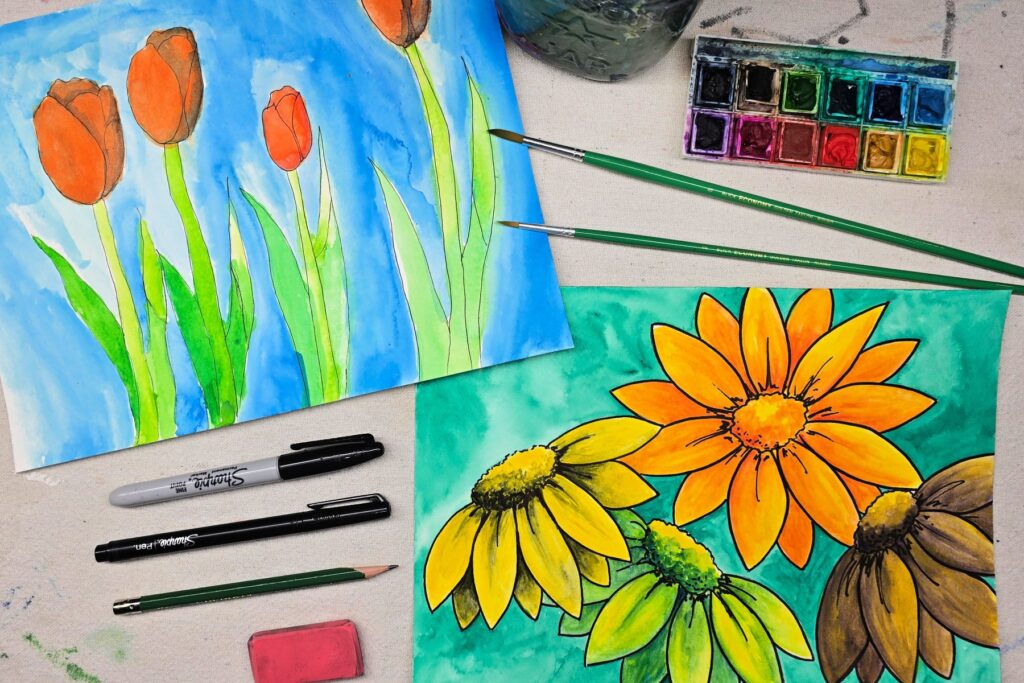College-aged youngsters will study varied coloration mixtures when shading with watercolor on this enjoyable venture. This fundamental method can simply be used at residence or within the classroom.
SHading Colour Selection
This venture focuses on just a few coloration concept choices in the case of shading in watercolors. Many youngsters default to utilizing black for shadows, however this lesson gives different choices which may be higher suited to their venture. We’ll discover these 4 coloration mixtures in at this time’s venture:
- Shading with Black
- Shading with Blue
- Shading with Analogous Colours
- Shading with Complementary Colours
Associated: Overview Analogous and Complementary Colours.
Provides Wanted to Make this Shading with Watercolor Artwork Mission

- Watercolor Paper
- Watercolor Paints
- Advantageous-Tip Everlasting Marker
- Pencil
- Paintbrushes
- Water
- Paper Towels
Instructions to Shading with Watercolor
Step 1

First, use a pencil to flippantly sketch a design on watercolor paper. Design ought to comprise a minimum of 4 flowers for shading comparability.
Step 2

Subsequent, hint last pencil sketch utilizing a fine-tip everlasting marker. Erase undesirable pencil traces.
Step 3

Then, use watercolor to color all 4 flowers the identical coloration.
Step 4

When coloured layer is dry, start including black shadows to your first flower. Apply fading shadows by utilizing a gradient wash to create a extra pure look on the flowers.
Step 5

Subsequent, transfer to a different flower and start shading utilizing solely a darkish blue watercolor pigment.
Step 6

Then, shade one other flower utilizing solely analogous colours. Bear in mind, analogous colours are merely these which can be subsequent to your authentic coloration on the colour wheel. For instance, yellow is between inexperienced and orange on the colour wheel, both of which might be used for shading on this occasion.
Step 7

Subsequent, shade the final flower utilizing solely a complementary coloration. Complementary colours are these reverse on the colour wheel akin to inexperienced and purple, blue and orange, purple and yellow.
Step 8

If desired, return to the dried flowers and paint further layers to brighten your design or darken your shadows. Use warning to not overwork and disrupt earlier layers.
Step 9

Then, paint space surrounding the flowers.
Step 10

Lastly, you’ll be able to add ending touches utilizing the everlasting marker as soon as paint is dry.
Completed Shading with Watercolor Artwork Mission

I like how our examples show completely different shading choices inside one single piece of artwork! Since these tasks are made on paper, they will simply be framed, clipped, or displayed in your most well-liked type.
Our Expertise Making this Shading with Watercolor Artwork Mission
What I like most about this venture is the way it showcases how simply coloration decisions impression our artwork. Every flower begins with the identical coloration, but the tip outcomes are vastly completely different. Some coloration mixtures create vibrant, cheerful flowers, whereas others seem to deaden or boring the flowers.
This venture can be a beautiful alternative to evaluation varied coloration concept classes when selecting analogous or complementary colours. If youngsters select to color orange flowers, they are going to quickly uncover that orange’s complementary coloration is blue. Quite than having two flowers shaded in the identical means, encourage your little one to attempt a special shade of blue to see how that alters the completed picture.
Prep Time
5 minutes
Lively Time
45 minutes
Complete Time
50 minutes
Issue
Medium
Estimated Value
$1
Supplies
- Watercolor Paper
- Watercolor Paints
Instruments
- Advantageous-Tip Everlasting Marker
- Pencil
- Paintbrushes
- Water
- Paper Towels
Directions
- Use a pencil to flippantly sketch a design on watercolor paper. Design ought to comprise a minimum of 4 flowers for shading comparability.
- Hint last pencil sketch utilizing a fine-tip everlasting marker. Erase undesirable pencil traces.
- Use watercolor to color all 4 flowers the identical coloration.
- When coloured layer is dry, start including black shadows to your first flower. Apply fading shadows by utilizing a gradient wash to create a extra pure look on the flowers.
- Transfer to a different flower and start shading utilizing solely a darkish blue watercolor pigment.
- Shade one other flower utilizing solely analogous colours. Bear in mind, analogous colours are merely these which can be subsequent to your authentic coloration on the colour wheel. For instance, yellow is between inexperienced and orange on the colour wheel, both of which might be used for shading on this occasion.
- Shade the final flower utilizing solely a complementary coloration. Complementary colours are these reverse on the colour wheel akin to inexperienced and purple, blue and orange, purple and yellow.
- If desired, return to the dried flowers and paint further layers to brighten your design or darken your shadows. Use warning to not overwork and disrupt earlier layers.
- Paint space surrounding the flowers.
- Add ending touches utilizing the everlasting marker as soon as paint is dry.
Notes
Shading with Watercolor Artwork Variations
- Adapt design to suit any season or theme.
- Apply shading with these coloration decisions in different mediums akin to coloured pencils and acrylic paints.
- Add further flowers and apply extra coloration mixtures for shading.
Shading with WAtercolor Artwork Variations
- Adapt design to suit any season or theme.
- Apply shading with these coloration decisions in different mediums akin to coloured pencils and acrylic paints.
- Add further flowers and apply extra coloration mixtures for shading.
Different Enjoyable Watercolor Artwork Tasks from Children Actions Weblog
Did your youngsters get pleasure from studying about shading with watercolor by utilizing these completely different coloration mixtures? Which coloration was their favourite shading choice on this venture?
